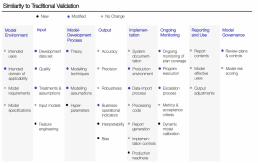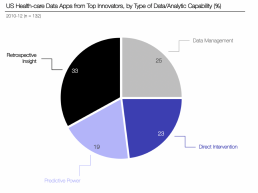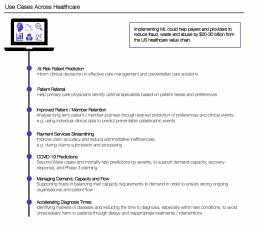As of 2016, there was estimated to be over 1.5-3 million data scientists worldwide – a number likely to have soared in the 4 years since – with ‘Finance & Insurance’, ‘Professional, Scientific & Technical Services’, and ‘Information Technology’ being the key sectors for talent. Over the past three years, we have had the pleasure of meeting thousands of data warehouse specialists, analysts, data scientists, PhD students, and developers, who all have an enormous passion for supporting clinical and executive leaders in simply looking forward. As the data custodians of healthcare providers, commissioners and systems, data leaders have often struggled with holding the necessary resources and capacity within local teams needed to deliver clinical, operational, tactical and strategic predictive content.
In the last six months, we have seen many incredible healthcare data custodians rise to the challenge of modelling and partnering to predict some extraordinary scenarios – from learning about and developing R0 rates, to modelling entire health system future demand and capacity requirements. Across Italy, France, Spain, and here at home in the NHS, we have been celebrating our front-line workers and the immense degree of pressure and hardship they have faced during the first wave of the pandemic. However, I use this opportunity to also thank many of our data heroes for providing strong and valuable predictions, vital to so many in planning for and tackling the difficulties brought about by COVID-19.
With healthcare providers now rapidly investing in advanced predictive and modelling capabilities, both at a local and system level, many IT / informatics teams are struggling to deliver credible predictions, largely due to this having been an area of notable underinvestment for many years. Despite excellent partnerships with universities, some programmes seeing PhD students use healthcare data to develop models for hospital systems for free or on small packages, many continue to struggle, especially given the timescales within which much of the planning and confidence needs to be delivered. There are also the significant issues of time to recruit, talent development, and cost of resources – real challenges facing teams across both the NHS and healthcare globally.

Indeed, leveraging the Machine Learning (ML) techniques central to driving modelling and predictive capabilities sees a broad host of challenges faced by payers and providers. While we have touched upon the restrictions caused by a tight talent market of data scientists, this is certainly not the only roadblock in the journey towards improved utilisation of these methods within the healthcare sector. Many organisations currently lack strong, if any, Artificial Intelligence (AI) strategies, with technological limitations and an underlying infrastructure of often fragmented data storage systems meaning many providers lack the foundation needed to deliver advanced modelling or predictive capabilities. Fundamental to all of this, however, is an unfortunately still common disbelief in “new technologies” and the potential benefits of AI/ML in supporting health systems. While progress has been made in this respect over recent years, the absence of the voice of a dedicated AI leader or advocate within such organisations will see taking the necessary steps towards integrating these techniques and truly delivering improved patient care, outcomes and overall efficiency remain obstructed.
Much of the existing way of operating within healthcare organisations and in developing novel health-data software applications revolves around a focus upon data management and retrospective insights; but the past decade has seen a significant shift in this trend. More and more innovation has begun to emerge from the fields of direct intervention from data analytics and delivering predictive power, comprising around 40% of the US federal government’s Health Data Initiative Forum back in 2010 and 2011. With the potential to reduce health-care system expenses by more than $300 billion, helping to avoid costly readmissions, enhance chronic disease understanding, and ensure better patient outcomes through higher standards of care within the best environments for their needs, it is clear that striving towards implementing this potential on a broader scale will be hugely beneficial to both healthcare organisations as a whole, and the very patients they serve.

Machine Learning and data science are very much set to transform the healthcare industry if utilised in the right way, leveraging vast amounts of data to build models that improve decision making, tailor services, and improve risk management. In light of the intense disruption and upheaval caused by COVID-19, utilising tools such as AI/ML and the potential they hold to support providers in navigating through response and recovery phases will be especially crucial. With COVID-19’s impact set to be seen for years to come, it is time for healthcare leaders and the workforce as a whole to begin applying data to improved decision making and patient care, bolstered by the right technology to achieve this at speed, scale and reduced cost.
Implementing this in the right way revolves around three key considerations; strong data infrastructure, organised data processes, and reducing the dependency on people to allow business continuity in times of crisis. As previously discussed, much of the existing infrastructure within our healthcare systems remains outdated, relying on legacy infrastructure that lacks the flexibility, scalability and affordability of modern infrastructures that are so critical to driving forward improvements to system-wide efficiency and downstream standards of patient care. Combined with reams of information that still sit in unstructured, disconnected forms – their sources often decentralised and lacking continuity between departments or providers – true understanding of patient pathways throughout their care journey and the operational efficiency of healthcare systems themselves are often incomplete and severely restricted.

Ensuring that all data is formatted in the correct structure, supported by a solid underlying infrastructure, is therefore an essential step in generating the in-depth insights needed to tackle the challenges of both COVID-19 related and pre-existing issues within our health systems – driving continued and improved efficiency, patient flow, and care standards in the face of immense pressures. From this fuller picture of the situation on the ground, deploying the intelligent capability provided by AI/ML technology further holds the key to alleviating the dependency and burden upon a workforce already facing colossal pressures. By leveraging the automated and predictive data capabilities of this technology, healthcare teams and leadership will be in a significantly stronger position to adapt to the challenges caused by COVID-19, armed with greater insights and the predictive outlook needed to plan responses pre-emptively and pro-actively. Through this, our healthcare workforce will be better able to focus on the patients at the heart of everything we do – supported by the vast data sources available rather than hindered by it.
While every health system and provider are well aware of the potential value that remains often sadly untapped within the data they collect and store, only 5% of NHS hospitals currently have access to an in-house data scientist. Supporting teams with data science technology in order to advance the healthcare landscape is truly vital as a way forward, enabling healthcare organisations to harness the power of advanced analytics and predictive intelligence. As such, at the heart of our Data Science Platform (DSP) is the goal of helping organisations transform their data into standard data models enriched with reference data, which are then run through significant quality checks to look at completeness, logical relationships, and business rules – all before generating our predictive data and codebase. Ultimately, the DSP was born with the aim of simplifying, speeding up, and industrialising the highly complex world of ML and AI for healthcare providers, this potential held within a platform built with all healthcare settings in mind.
Be it acute, mental health, or community care, the DSP utilises D&D’s proven set of tools and expertise to transform healthcare organisations and systems into forward-looking, analytics-enabled partnerships, further helping to drive real, tangible value against proven use cases. Whether the goal is improving health outcomes, increasing efficiency, or driving innovation and growth, the DSP has the power to shape the industry meaningfully. Health systems have access to vast and growing amounts of internal and external data; a wealth of knowledge that holds great potential for future improvements but are often left untapped. The promise this volume of data creates in delivering better understanding and predictions around patient complexity, capacity constraints, and resources requires significant analytical capabilities in order to truly capture the full value available – this forming the very core of the DSP’s functionality.
As such, our goal is to provide healthcare leaders and frontline workers with the ability to leverage the vast quantities of data generated by health systems through the application of the DSP’s advanced analytics, in-depth insights, and predictive modelling, in order to enhance overall performance and deliver greater standards of care to patients. As we now announce the launch of Draper & Dash’s ground-breaking Health Data Science Platform, we welcome any who are interested in learning more to join us at our webinar on the 30th September, to contact us at info@draperanddash.com.